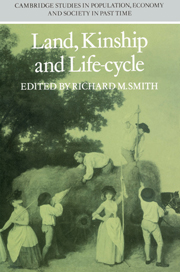Book contents
- Frontmatter
- Contents
- List of contributors
- Preface
- 1 Some issues concerning families and their property in rural England 1250–1800
- 2 Population pressure, inheritance and the land market in a fourteenth-century peasant community
- 3 Families and their land in an area of partible inheritance: Redgrave, Suffolk 1260–1320
- 4 Population changes and the transfer of customary land on a Cambridgeshire manor in the fourteenth century
- 5 Industrial employment and the rural land market 1380– 1520
- 6 Changes in the size of peasant holdings in some west midland villages 1400–1540
- 7 The erosion of the family–land bond in the late fourteenth and fifteenth centuries: a methodological note
- 8 Changes in the link between families and land in the west midlands in the fourteenth and fifteenth centuries
- 9 Kinship in an English village: Terling, Essex 1550–1700
- 10 The myth of the peasantry: family and economy in a northern parish
- 11 Poverty, poor relief and the life-cycle: some evidence from seventeenth-century Norfolk
- 12 The receipt of poor relief and family situation: Aldenham, Hertfordshire 1630–90
- 13 Widows in pre-industrial society: an essay upon their economic functions
- 14 Real property, marriage and children: the evidence from four pre-industrial communities
- 15 The nineteenth-century peasantry of Melbourn, Cambridgeshire
- Consolidated Bibliography
- Index
11 - Poverty, poor relief and the life-cycle: some evidence from seventeenth-century Norfolk
Published online by Cambridge University Press: 19 October 2009
- Frontmatter
- Contents
- List of contributors
- Preface
- 1 Some issues concerning families and their property in rural England 1250–1800
- 2 Population pressure, inheritance and the land market in a fourteenth-century peasant community
- 3 Families and their land in an area of partible inheritance: Redgrave, Suffolk 1260–1320
- 4 Population changes and the transfer of customary land on a Cambridgeshire manor in the fourteenth century
- 5 Industrial employment and the rural land market 1380– 1520
- 6 Changes in the size of peasant holdings in some west midland villages 1400–1540
- 7 The erosion of the family–land bond in the late fourteenth and fifteenth centuries: a methodological note
- 8 Changes in the link between families and land in the west midlands in the fourteenth and fifteenth centuries
- 9 Kinship in an English village: Terling, Essex 1550–1700
- 10 The myth of the peasantry: family and economy in a northern parish
- 11 Poverty, poor relief and the life-cycle: some evidence from seventeenth-century Norfolk
- 12 The receipt of poor relief and family situation: Aldenham, Hertfordshire 1630–90
- 13 Widows in pre-industrial society: an essay upon their economic functions
- 14 Real property, marriage and children: the evidence from four pre-industrial communities
- 15 The nineteenth-century peasantry of Melbourn, Cambridgeshire
- Consolidated Bibliography
- Index
Summary
In October 1602 Widow Dixe of Kelling petitioned Sir Nathaniel Bacon, JP, for relief. Her plea is that she has three children at her charge, that she ‘hath no meanes for living but hir hand labor: is sett on worke by a comber onely of whom shee is sometyme not wrought by a weeks space: That shee had no relief of the overseers since Christmas, except iis vid for her rent at Midsomer’, that her landlord has turned her out and that the overseer is refusing to help. In January 1662 George Cock of Holt was granted an annual pension of 40s out of county funds in response to a petition subscribed by ‘most of the Chiefe inhabitants of the same towne’ and sworn to by ‘severall persons of Creditt’. In it he claimed that about thirty years earlier he had been pressed and wounded in Charles I's overseas wars; ‘but he beinge then younge & somewt able to gett a poore livelyhood by mendinge of shoes would not put the country to any charge for his maintenance, but he being now very old & very lame by reason of his sayd wounds is not able to worke any longer for his liveinge’.
Neither of these pleas for relief is particularly remarkable in itself, but both are valuable for focusing on the way in which institutional relief fitted into the livelihood of the poor.
- Type
- Chapter
- Information
- Land, Kinship and Life-Cycle , pp. 351 - 404Publisher: Cambridge University PressPrint publication year: 1985
- 7
- Cited by

